NSG2IIH - Strategies for Health Inequality in Indigenous Australians
VerifiedAdded on 2023/06/04
|9
|2518
|388
Essay
AI Summary
This essay examines strategies to address health inequality experienced by Aboriginal and Torres Strait Islander Australians, focusing on the role of Aboriginal Community Controlled Health Services (ACCHS) and the importance of self-determination. It discusses how the ACCHS model reflects Indigenous understandings of health and wellbeing, highlighting specific programs like the Victorian Mental Health Network. The essay also addresses the National Safety and Quality Health Service (NSQHS) standards and the Nursing and Midwifery Board of Australia (NMBA) codes of conduct, emphasizing cultural safety and the need for healthcare professionals to create welcoming environments and build partnerships with Indigenous communities to improve health outcomes and reduce disparities. Desklib offers similar solved assignments and resources for students.
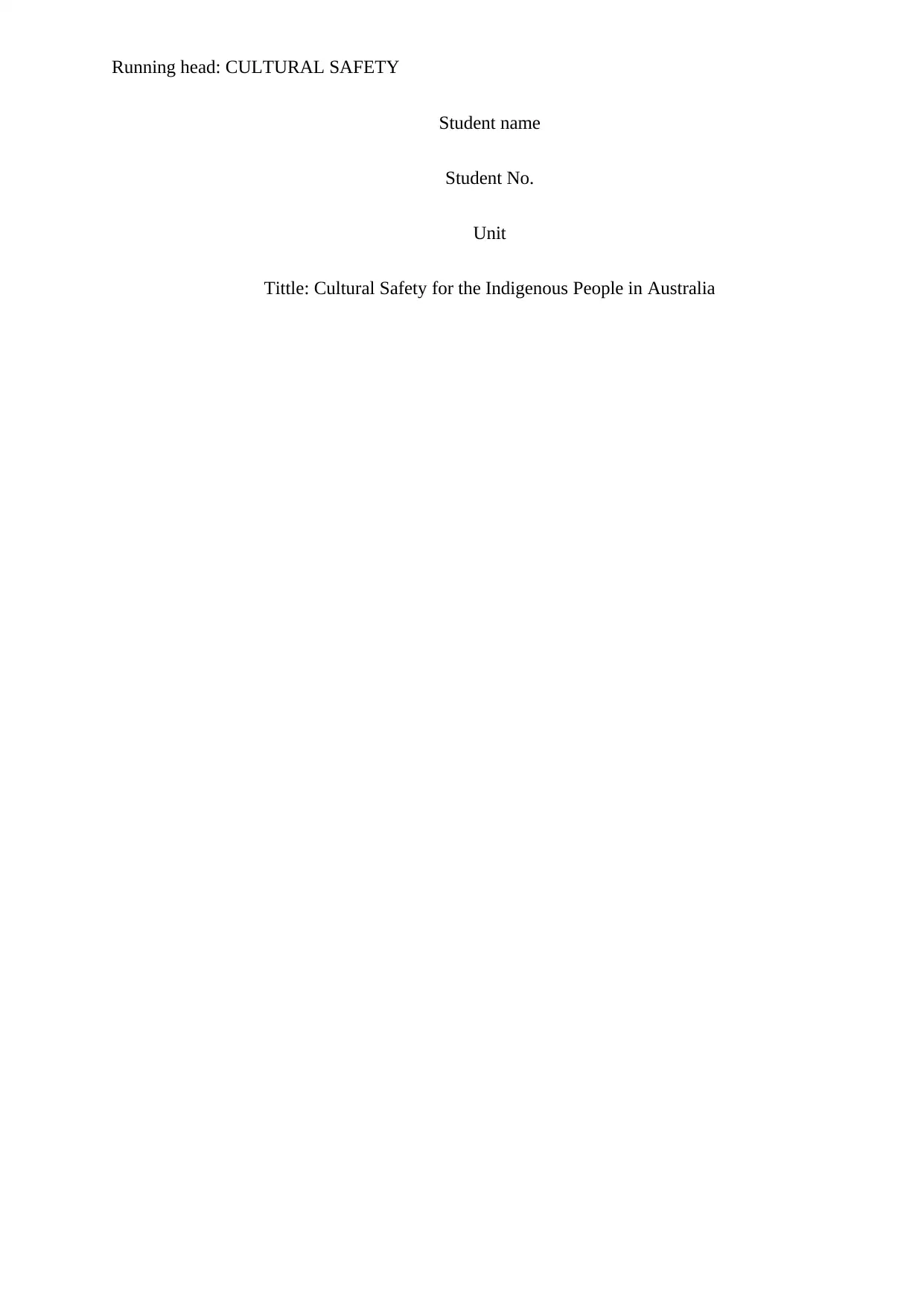
Running head: CULTURAL SAFETY
Student name
Student No.
Unit
Tittle: Cultural Safety for the Indigenous People in Australia
Student name
Student No.
Unit
Tittle: Cultural Safety for the Indigenous People in Australia
Paraphrase This Document
Need a fresh take? Get an instant paraphrase of this document with our AI Paraphraser
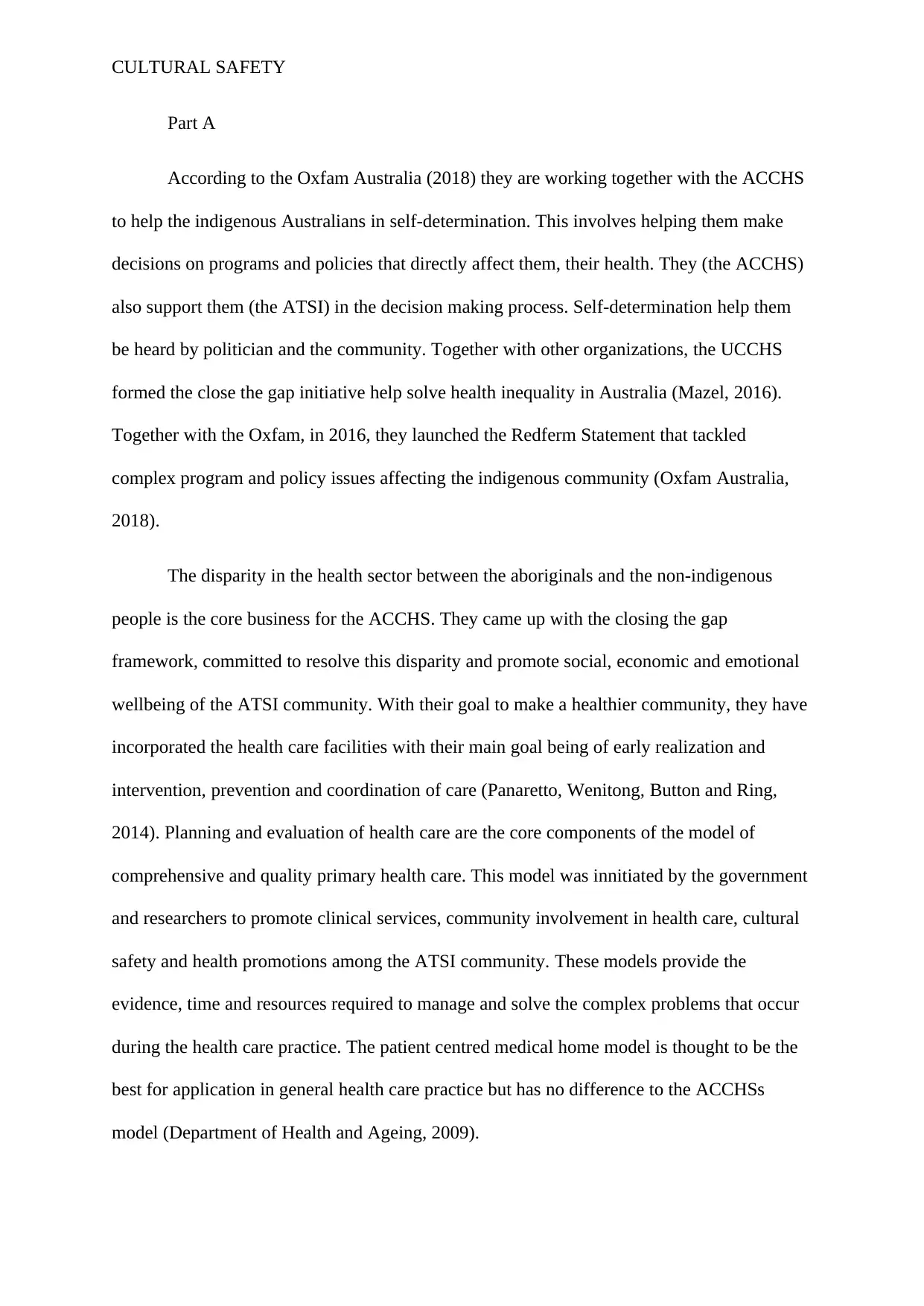
CULTURAL SAFETY
Part A
According to the Oxfam Australia (2018) they are working together with the ACCHS
to help the indigenous Australians in self-determination. This involves helping them make
decisions on programs and policies that directly affect them, their health. They (the ACCHS)
also support them (the ATSI) in the decision making process. Self-determination help them
be heard by politician and the community. Together with other organizations, the UCCHS
formed the close the gap initiative help solve health inequality in Australia (Mazel, 2016).
Together with the Oxfam, in 2016, they launched the Redferm Statement that tackled
complex program and policy issues affecting the indigenous community (Oxfam Australia,
2018).
The disparity in the health sector between the aboriginals and the non-indigenous
people is the core business for the ACCHS. They came up with the closing the gap
framework, committed to resolve this disparity and promote social, economic and emotional
wellbeing of the ATSI community. With their goal to make a healthier community, they have
incorporated the health care facilities with their main goal being of early realization and
intervention, prevention and coordination of care (Panaretto, Wenitong, Button and Ring,
2014). Planning and evaluation of health care are the core components of the model of
comprehensive and quality primary health care. This model was innitiated by the government
and researchers to promote clinical services, community involvement in health care, cultural
safety and health promotions among the ATSI community. These models provide the
evidence, time and resources required to manage and solve the complex problems that occur
during the health care practice. The patient centred medical home model is thought to be the
best for application in general health care practice but has no difference to the ACCHSs
model (Department of Health and Ageing, 2009).
Part A
According to the Oxfam Australia (2018) they are working together with the ACCHS
to help the indigenous Australians in self-determination. This involves helping them make
decisions on programs and policies that directly affect them, their health. They (the ACCHS)
also support them (the ATSI) in the decision making process. Self-determination help them
be heard by politician and the community. Together with other organizations, the UCCHS
formed the close the gap initiative help solve health inequality in Australia (Mazel, 2016).
Together with the Oxfam, in 2016, they launched the Redferm Statement that tackled
complex program and policy issues affecting the indigenous community (Oxfam Australia,
2018).
The disparity in the health sector between the aboriginals and the non-indigenous
people is the core business for the ACCHS. They came up with the closing the gap
framework, committed to resolve this disparity and promote social, economic and emotional
wellbeing of the ATSI community. With their goal to make a healthier community, they have
incorporated the health care facilities with their main goal being of early realization and
intervention, prevention and coordination of care (Panaretto, Wenitong, Button and Ring,
2014). Planning and evaluation of health care are the core components of the model of
comprehensive and quality primary health care. This model was innitiated by the government
and researchers to promote clinical services, community involvement in health care, cultural
safety and health promotions among the ATSI community. These models provide the
evidence, time and resources required to manage and solve the complex problems that occur
during the health care practice. The patient centred medical home model is thought to be the
best for application in general health care practice but has no difference to the ACCHSs
model (Department of Health and Ageing, 2009).
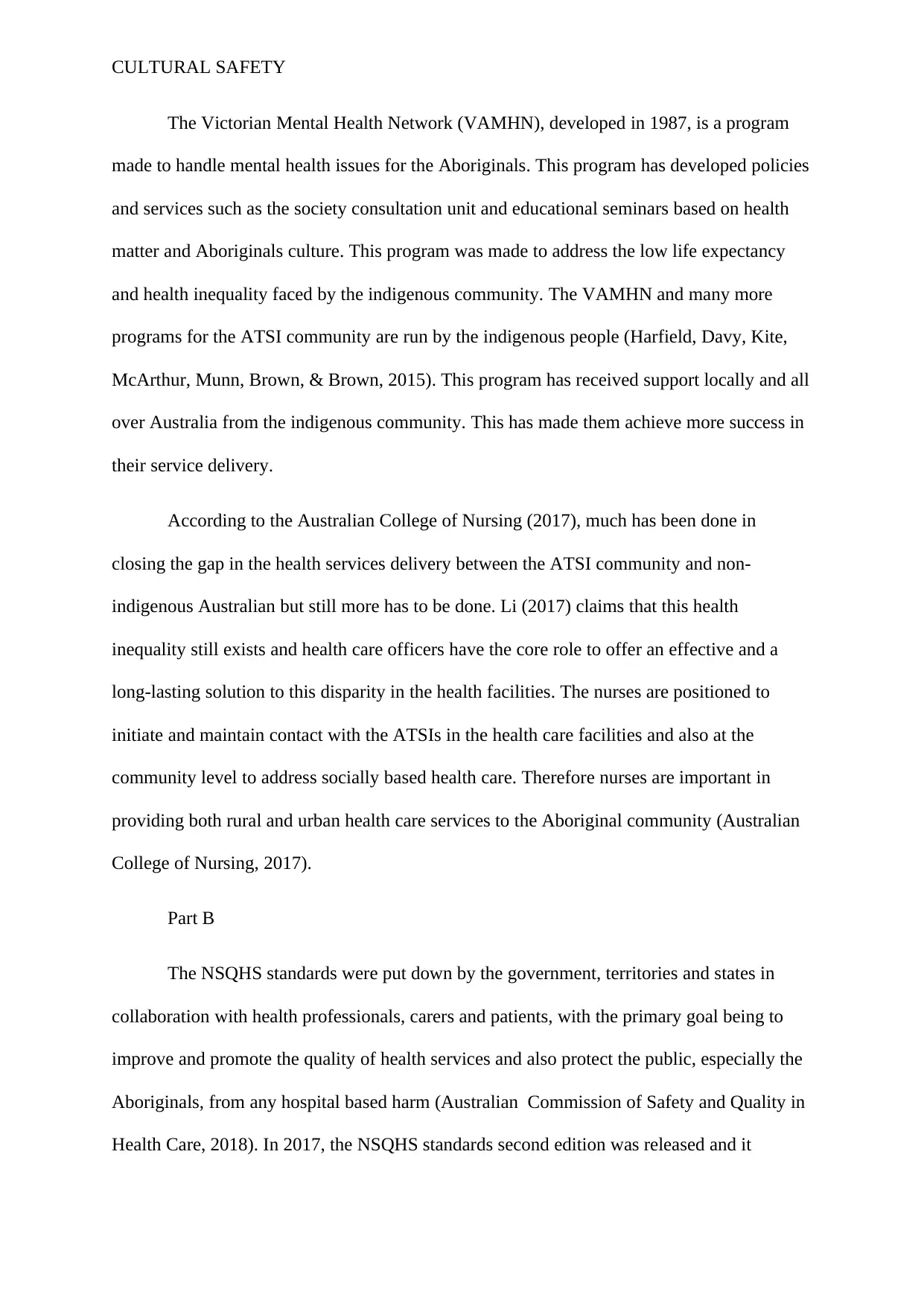
CULTURAL SAFETY
The Victorian Mental Health Network (VAMHN), developed in 1987, is a program
made to handle mental health issues for the Aboriginals. This program has developed policies
and services such as the society consultation unit and educational seminars based on health
matter and Aboriginals culture. This program was made to address the low life expectancy
and health inequality faced by the indigenous community. The VAMHN and many more
programs for the ATSI community are run by the indigenous people (Harfield, Davy, Kite,
McArthur, Munn, Brown, & Brown, 2015). This program has received support locally and all
over Australia from the indigenous community. This has made them achieve more success in
their service delivery.
According to the Australian College of Nursing (2017), much has been done in
closing the gap in the health services delivery between the ATSI community and non-
indigenous Australian but still more has to be done. Li (2017) claims that this health
inequality still exists and health care officers have the core role to offer an effective and a
long-lasting solution to this disparity in the health facilities. The nurses are positioned to
initiate and maintain contact with the ATSIs in the health care facilities and also at the
community level to address socially based health care. Therefore nurses are important in
providing both rural and urban health care services to the Aboriginal community (Australian
College of Nursing, 2017).
Part B
The NSQHS standards were put down by the government, territories and states in
collaboration with health professionals, carers and patients, with the primary goal being to
improve and promote the quality of health services and also protect the public, especially the
Aboriginals, from any hospital based harm (Australian Commission of Safety and Quality in
Health Care, 2018). In 2017, the NSQHS standards second edition was released and it
The Victorian Mental Health Network (VAMHN), developed in 1987, is a program
made to handle mental health issues for the Aboriginals. This program has developed policies
and services such as the society consultation unit and educational seminars based on health
matter and Aboriginals culture. This program was made to address the low life expectancy
and health inequality faced by the indigenous community. The VAMHN and many more
programs for the ATSI community are run by the indigenous people (Harfield, Davy, Kite,
McArthur, Munn, Brown, & Brown, 2015). This program has received support locally and all
over Australia from the indigenous community. This has made them achieve more success in
their service delivery.
According to the Australian College of Nursing (2017), much has been done in
closing the gap in the health services delivery between the ATSI community and non-
indigenous Australian but still more has to be done. Li (2017) claims that this health
inequality still exists and health care officers have the core role to offer an effective and a
long-lasting solution to this disparity in the health facilities. The nurses are positioned to
initiate and maintain contact with the ATSIs in the health care facilities and also at the
community level to address socially based health care. Therefore nurses are important in
providing both rural and urban health care services to the Aboriginal community (Australian
College of Nursing, 2017).
Part B
The NSQHS standards were put down by the government, territories and states in
collaboration with health professionals, carers and patients, with the primary goal being to
improve and promote the quality of health services and also protect the public, especially the
Aboriginals, from any hospital based harm (Australian Commission of Safety and Quality in
Health Care, 2018). In 2017, the NSQHS standards second edition was released and it
⊘ This is a preview!⊘
Do you want full access?
Subscribe today to unlock all pages.

Trusted by 1+ million students worldwide
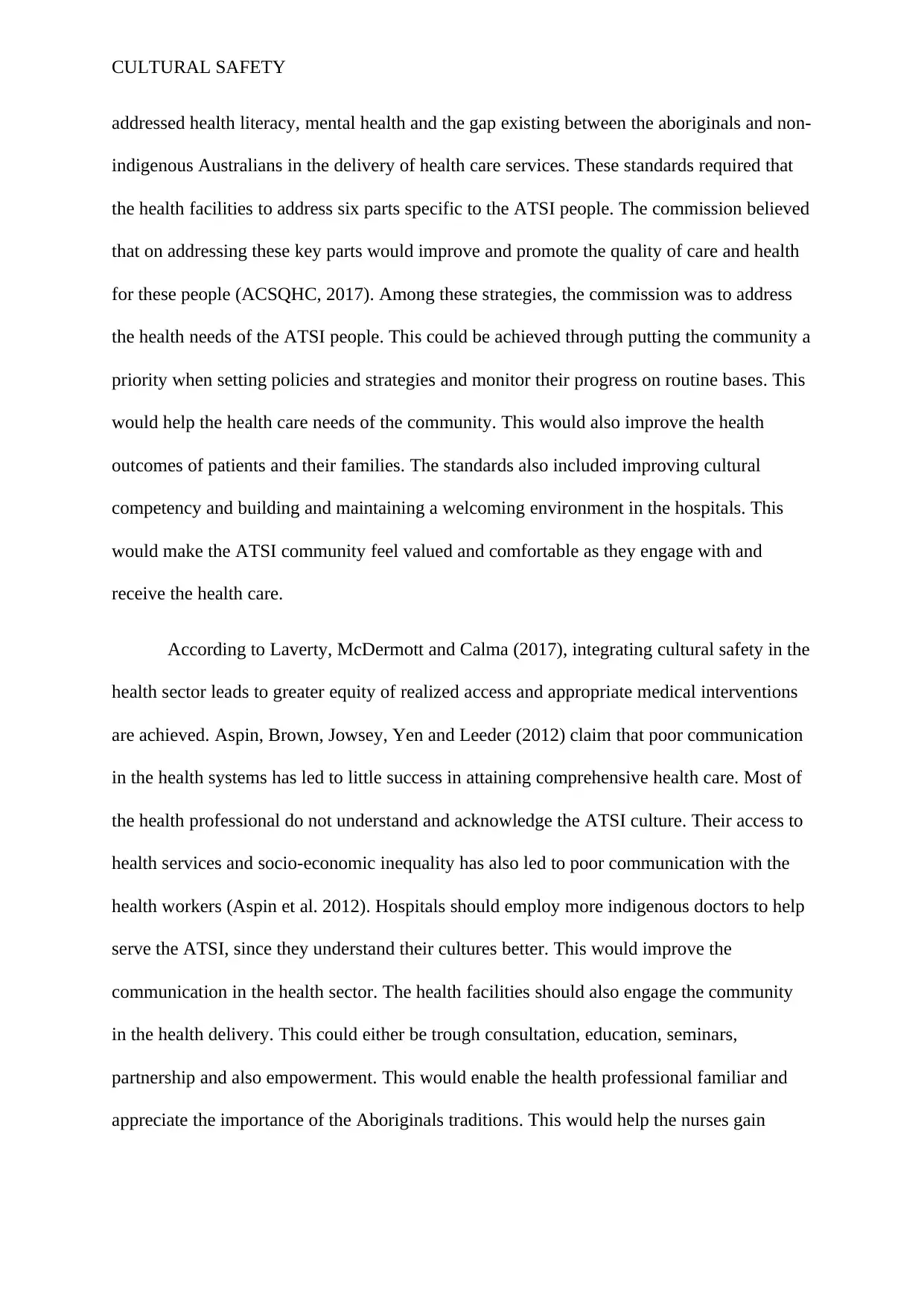
CULTURAL SAFETY
addressed health literacy, mental health and the gap existing between the aboriginals and non-
indigenous Australians in the delivery of health care services. These standards required that
the health facilities to address six parts specific to the ATSI people. The commission believed
that on addressing these key parts would improve and promote the quality of care and health
for these people (ACSQHC, 2017). Among these strategies, the commission was to address
the health needs of the ATSI people. This could be achieved through putting the community a
priority when setting policies and strategies and monitor their progress on routine bases. This
would help the health care needs of the community. This would also improve the health
outcomes of patients and their families. The standards also included improving cultural
competency and building and maintaining a welcoming environment in the hospitals. This
would make the ATSI community feel valued and comfortable as they engage with and
receive the health care.
According to Laverty, McDermott and Calma (2017), integrating cultural safety in the
health sector leads to greater equity of realized access and appropriate medical interventions
are achieved. Aspin, Brown, Jowsey, Yen and Leeder (2012) claim that poor communication
in the health systems has led to little success in attaining comprehensive health care. Most of
the health professional do not understand and acknowledge the ATSI culture. Their access to
health services and socio-economic inequality has also led to poor communication with the
health workers (Aspin et al. 2012). Hospitals should employ more indigenous doctors to help
serve the ATSI, since they understand their cultures better. This would improve the
communication in the health sector. The health facilities should also engage the community
in the health delivery. This could either be trough consultation, education, seminars,
partnership and also empowerment. This would enable the health professional familiar and
appreciate the importance of the Aboriginals traditions. This would help the nurses gain
addressed health literacy, mental health and the gap existing between the aboriginals and non-
indigenous Australians in the delivery of health care services. These standards required that
the health facilities to address six parts specific to the ATSI people. The commission believed
that on addressing these key parts would improve and promote the quality of care and health
for these people (ACSQHC, 2017). Among these strategies, the commission was to address
the health needs of the ATSI people. This could be achieved through putting the community a
priority when setting policies and strategies and monitor their progress on routine bases. This
would help the health care needs of the community. This would also improve the health
outcomes of patients and their families. The standards also included improving cultural
competency and building and maintaining a welcoming environment in the hospitals. This
would make the ATSI community feel valued and comfortable as they engage with and
receive the health care.
According to Laverty, McDermott and Calma (2017), integrating cultural safety in the
health sector leads to greater equity of realized access and appropriate medical interventions
are achieved. Aspin, Brown, Jowsey, Yen and Leeder (2012) claim that poor communication
in the health systems has led to little success in attaining comprehensive health care. Most of
the health professional do not understand and acknowledge the ATSI culture. Their access to
health services and socio-economic inequality has also led to poor communication with the
health workers (Aspin et al. 2012). Hospitals should employ more indigenous doctors to help
serve the ATSI, since they understand their cultures better. This would improve the
communication in the health sector. The health facilities should also engage the community
in the health delivery. This could either be trough consultation, education, seminars,
partnership and also empowerment. This would enable the health professional familiar and
appreciate the importance of the Aboriginals traditions. This would help the nurses gain
Paraphrase This Document
Need a fresh take? Get an instant paraphrase of this document with our AI Paraphraser
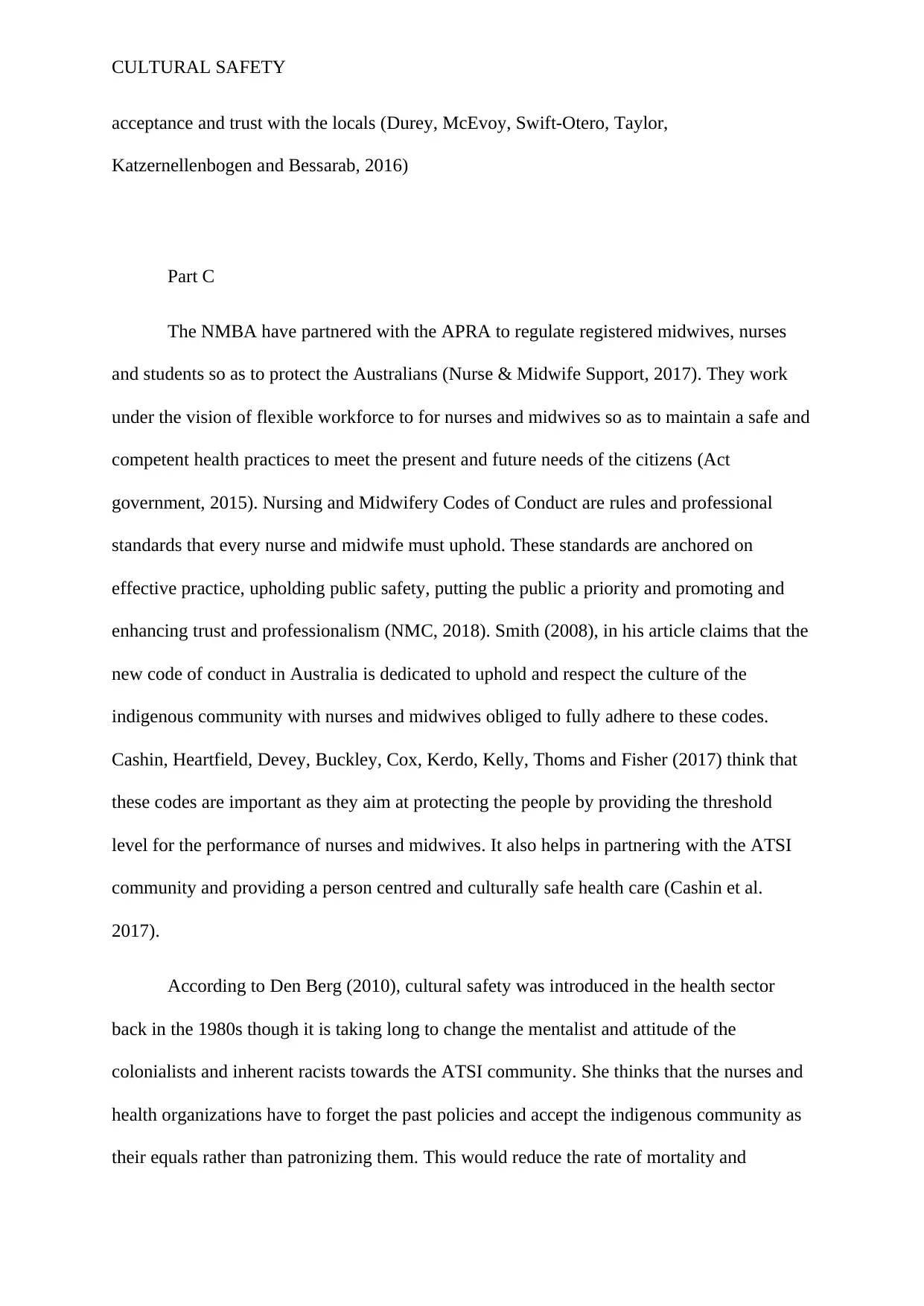
CULTURAL SAFETY
acceptance and trust with the locals (Durey, McEvoy, Swift-Otero, Taylor,
Katzernellenbogen and Bessarab, 2016)
Part C
The NMBA have partnered with the APRA to regulate registered midwives, nurses
and students so as to protect the Australians (Nurse & Midwife Support, 2017). They work
under the vision of flexible workforce to for nurses and midwives so as to maintain a safe and
competent health practices to meet the present and future needs of the citizens (Act
government, 2015). Nursing and Midwifery Codes of Conduct are rules and professional
standards that every nurse and midwife must uphold. These standards are anchored on
effective practice, upholding public safety, putting the public a priority and promoting and
enhancing trust and professionalism (NMC, 2018). Smith (2008), in his article claims that the
new code of conduct in Australia is dedicated to uphold and respect the culture of the
indigenous community with nurses and midwives obliged to fully adhere to these codes.
Cashin, Heartfield, Devey, Buckley, Cox, Kerdo, Kelly, Thoms and Fisher (2017) think that
these codes are important as they aim at protecting the people by providing the threshold
level for the performance of nurses and midwives. It also helps in partnering with the ATSI
community and providing a person centred and culturally safe health care (Cashin et al.
2017).
According to Den Berg (2010), cultural safety was introduced in the health sector
back in the 1980s though it is taking long to change the mentalist and attitude of the
colonialists and inherent racists towards the ATSI community. She thinks that the nurses and
health organizations have to forget the past policies and accept the indigenous community as
their equals rather than patronizing them. This would reduce the rate of mortality and
acceptance and trust with the locals (Durey, McEvoy, Swift-Otero, Taylor,
Katzernellenbogen and Bessarab, 2016)
Part C
The NMBA have partnered with the APRA to regulate registered midwives, nurses
and students so as to protect the Australians (Nurse & Midwife Support, 2017). They work
under the vision of flexible workforce to for nurses and midwives so as to maintain a safe and
competent health practices to meet the present and future needs of the citizens (Act
government, 2015). Nursing and Midwifery Codes of Conduct are rules and professional
standards that every nurse and midwife must uphold. These standards are anchored on
effective practice, upholding public safety, putting the public a priority and promoting and
enhancing trust and professionalism (NMC, 2018). Smith (2008), in his article claims that the
new code of conduct in Australia is dedicated to uphold and respect the culture of the
indigenous community with nurses and midwives obliged to fully adhere to these codes.
Cashin, Heartfield, Devey, Buckley, Cox, Kerdo, Kelly, Thoms and Fisher (2017) think that
these codes are important as they aim at protecting the people by providing the threshold
level for the performance of nurses and midwives. It also helps in partnering with the ATSI
community and providing a person centred and culturally safe health care (Cashin et al.
2017).
According to Den Berg (2010), cultural safety was introduced in the health sector
back in the 1980s though it is taking long to change the mentalist and attitude of the
colonialists and inherent racists towards the ATSI community. She thinks that the nurses and
health organizations have to forget the past policies and accept the indigenous community as
their equals rather than patronizing them. This would reduce the rate of mortality and
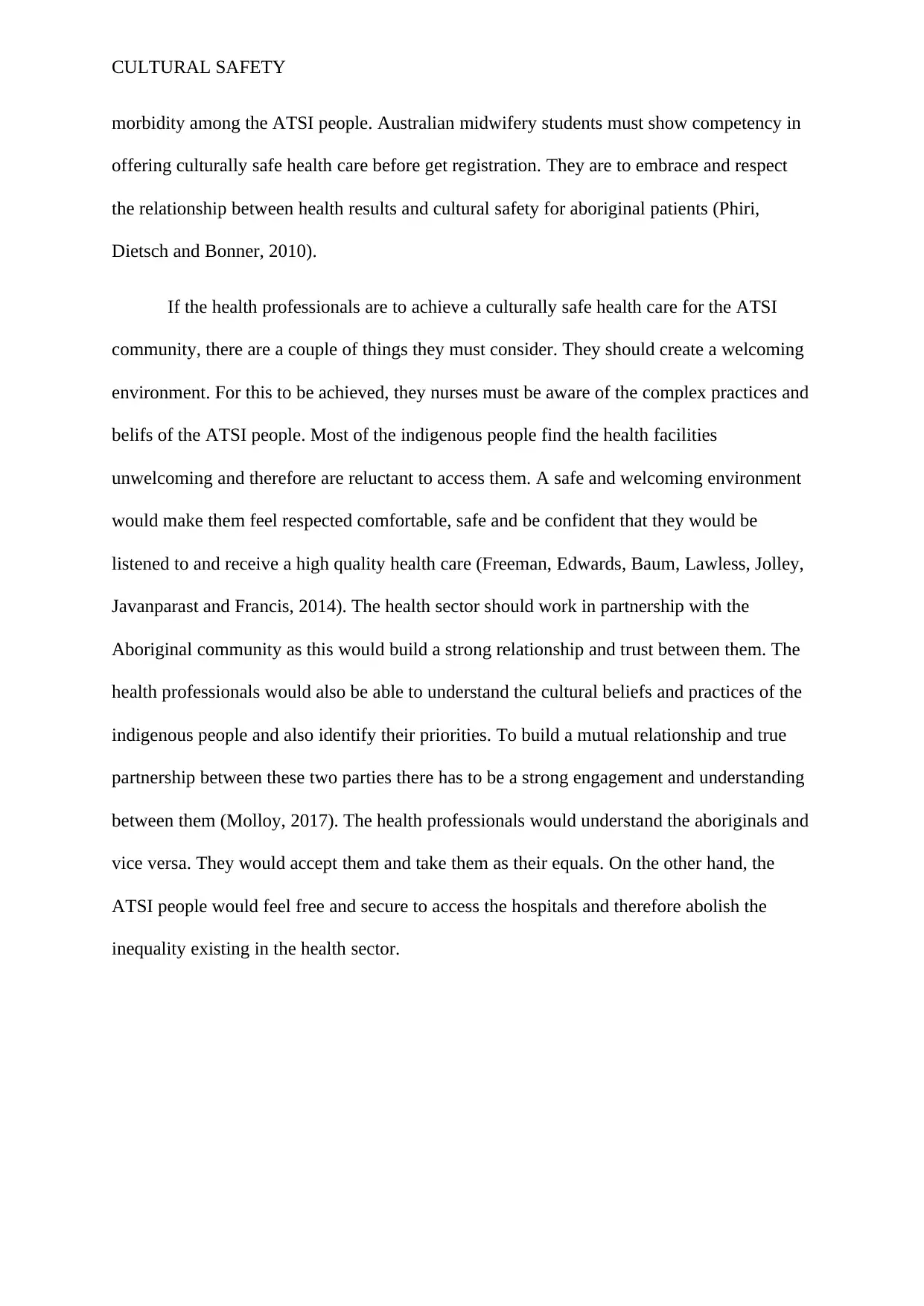
CULTURAL SAFETY
morbidity among the ATSI people. Australian midwifery students must show competency in
offering culturally safe health care before get registration. They are to embrace and respect
the relationship between health results and cultural safety for aboriginal patients (Phiri,
Dietsch and Bonner, 2010).
If the health professionals are to achieve a culturally safe health care for the ATSI
community, there are a couple of things they must consider. They should create a welcoming
environment. For this to be achieved, they nurses must be aware of the complex practices and
belifs of the ATSI people. Most of the indigenous people find the health facilities
unwelcoming and therefore are reluctant to access them. A safe and welcoming environment
would make them feel respected comfortable, safe and be confident that they would be
listened to and receive a high quality health care (Freeman, Edwards, Baum, Lawless, Jolley,
Javanparast and Francis, 2014). The health sector should work in partnership with the
Aboriginal community as this would build a strong relationship and trust between them. The
health professionals would also be able to understand the cultural beliefs and practices of the
indigenous people and also identify their priorities. To build a mutual relationship and true
partnership between these two parties there has to be a strong engagement and understanding
between them (Molloy, 2017). The health professionals would understand the aboriginals and
vice versa. They would accept them and take them as their equals. On the other hand, the
ATSI people would feel free and secure to access the hospitals and therefore abolish the
inequality existing in the health sector.
morbidity among the ATSI people. Australian midwifery students must show competency in
offering culturally safe health care before get registration. They are to embrace and respect
the relationship between health results and cultural safety for aboriginal patients (Phiri,
Dietsch and Bonner, 2010).
If the health professionals are to achieve a culturally safe health care for the ATSI
community, there are a couple of things they must consider. They should create a welcoming
environment. For this to be achieved, they nurses must be aware of the complex practices and
belifs of the ATSI people. Most of the indigenous people find the health facilities
unwelcoming and therefore are reluctant to access them. A safe and welcoming environment
would make them feel respected comfortable, safe and be confident that they would be
listened to and receive a high quality health care (Freeman, Edwards, Baum, Lawless, Jolley,
Javanparast and Francis, 2014). The health sector should work in partnership with the
Aboriginal community as this would build a strong relationship and trust between them. The
health professionals would also be able to understand the cultural beliefs and practices of the
indigenous people and also identify their priorities. To build a mutual relationship and true
partnership between these two parties there has to be a strong engagement and understanding
between them (Molloy, 2017). The health professionals would understand the aboriginals and
vice versa. They would accept them and take them as their equals. On the other hand, the
ATSI people would feel free and secure to access the hospitals and therefore abolish the
inequality existing in the health sector.
⊘ This is a preview!⊘
Do you want full access?
Subscribe today to unlock all pages.

Trusted by 1+ million students worldwide
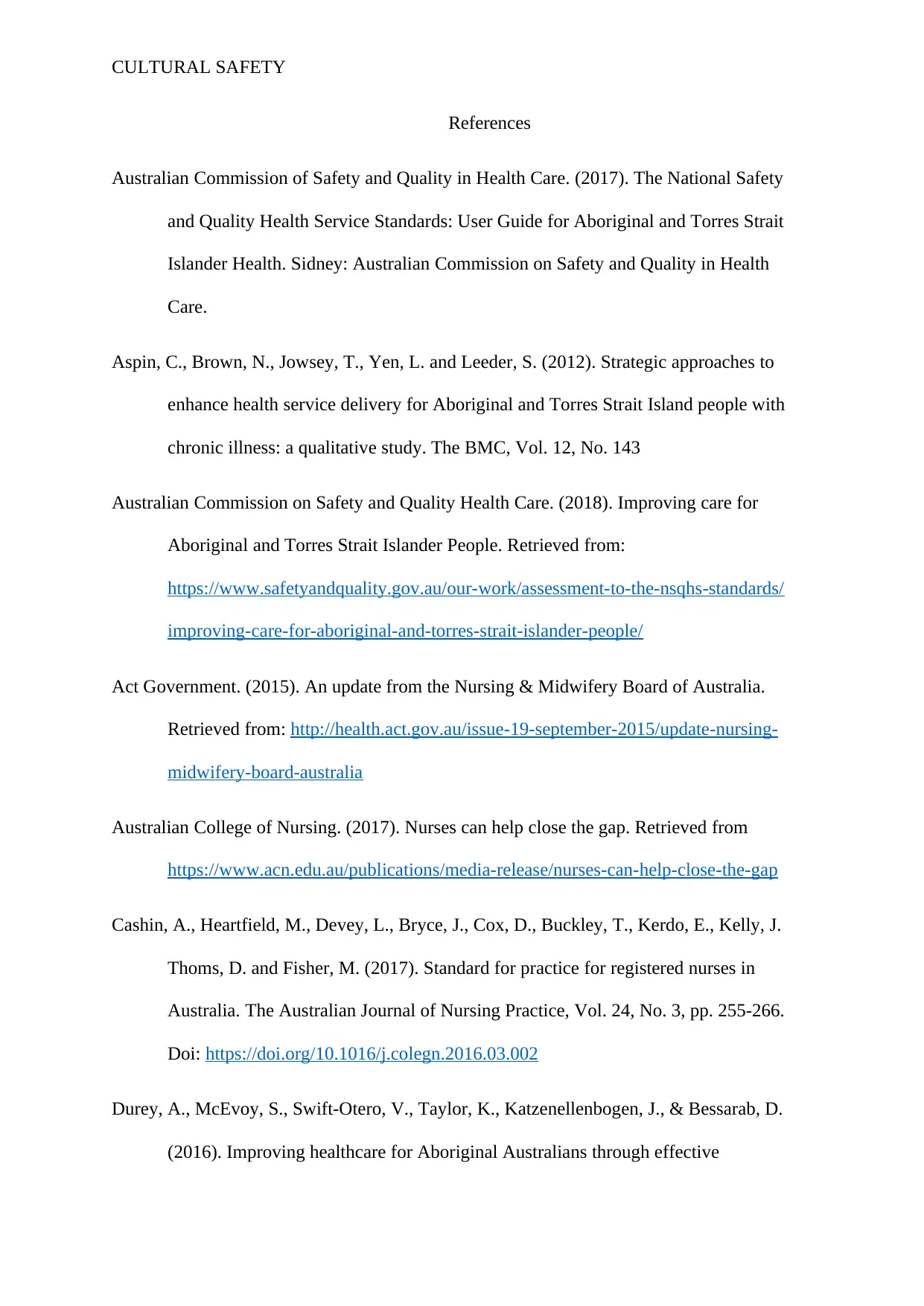
CULTURAL SAFETY
References
Australian Commission of Safety and Quality in Health Care. (2017). The National Safety
and Quality Health Service Standards: User Guide for Aboriginal and Torres Strait
Islander Health. Sidney: Australian Commission on Safety and Quality in Health
Care.
Aspin, C., Brown, N., Jowsey, T., Yen, L. and Leeder, S. (2012). Strategic approaches to
enhance health service delivery for Aboriginal and Torres Strait Island people with
chronic illness: a qualitative study. The BMC, Vol. 12, No. 143
Australian Commission on Safety and Quality Health Care. (2018). Improving care for
Aboriginal and Torres Strait Islander People. Retrieved from:
https://www.safetyandquality.gov.au/our-work/assessment-to-the-nsqhs-standards/
improving-care-for-aboriginal-and-torres-strait-islander-people/
Act Government. (2015). An update from the Nursing & Midwifery Board of Australia.
Retrieved from: http://health.act.gov.au/issue-19-september-2015/update-nursing-
midwifery-board-australia
Australian College of Nursing. (2017). Nurses can help close the gap. Retrieved from
https://www.acn.edu.au/publications/media-release/nurses-can-help-close-the-gap
Cashin, A., Heartfield, M., Devey, L., Bryce, J., Cox, D., Buckley, T., Kerdo, E., Kelly, J.
Thoms, D. and Fisher, M. (2017). Standard for practice for registered nurses in
Australia. The Australian Journal of Nursing Practice, Vol. 24, No. 3, pp. 255-266.
Doi: https://doi.org/10.1016/j.colegn.2016.03.002
Durey, A., McEvoy, S., Swift-Otero, V., Taylor, K., Katzenellenbogen, J., & Bessarab, D.
(2016). Improving healthcare for Aboriginal Australians through effective
References
Australian Commission of Safety and Quality in Health Care. (2017). The National Safety
and Quality Health Service Standards: User Guide for Aboriginal and Torres Strait
Islander Health. Sidney: Australian Commission on Safety and Quality in Health
Care.
Aspin, C., Brown, N., Jowsey, T., Yen, L. and Leeder, S. (2012). Strategic approaches to
enhance health service delivery for Aboriginal and Torres Strait Island people with
chronic illness: a qualitative study. The BMC, Vol. 12, No. 143
Australian Commission on Safety and Quality Health Care. (2018). Improving care for
Aboriginal and Torres Strait Islander People. Retrieved from:
https://www.safetyandquality.gov.au/our-work/assessment-to-the-nsqhs-standards/
improving-care-for-aboriginal-and-torres-strait-islander-people/
Act Government. (2015). An update from the Nursing & Midwifery Board of Australia.
Retrieved from: http://health.act.gov.au/issue-19-september-2015/update-nursing-
midwifery-board-australia
Australian College of Nursing. (2017). Nurses can help close the gap. Retrieved from
https://www.acn.edu.au/publications/media-release/nurses-can-help-close-the-gap
Cashin, A., Heartfield, M., Devey, L., Bryce, J., Cox, D., Buckley, T., Kerdo, E., Kelly, J.
Thoms, D. and Fisher, M. (2017). Standard for practice for registered nurses in
Australia. The Australian Journal of Nursing Practice, Vol. 24, No. 3, pp. 255-266.
Doi: https://doi.org/10.1016/j.colegn.2016.03.002
Durey, A., McEvoy, S., Swift-Otero, V., Taylor, K., Katzenellenbogen, J., & Bessarab, D.
(2016). Improving healthcare for Aboriginal Australians through effective
Paraphrase This Document
Need a fresh take? Get an instant paraphrase of this document with our AI Paraphraser
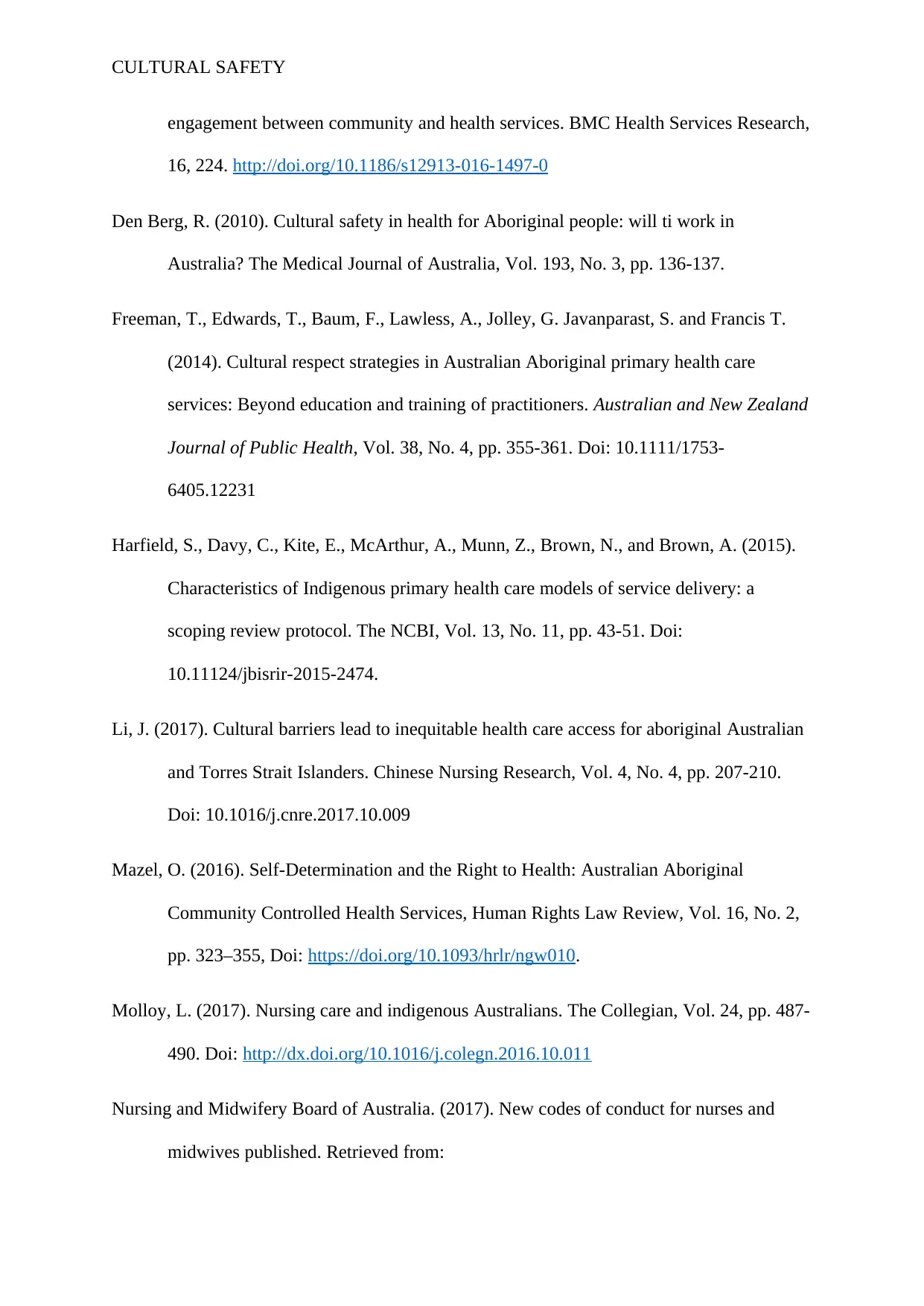
CULTURAL SAFETY
engagement between community and health services. BMC Health Services Research,
16, 224. http://doi.org/10.1186/s12913-016-1497-0
Den Berg, R. (2010). Cultural safety in health for Aboriginal people: will ti work in
Australia? The Medical Journal of Australia, Vol. 193, No. 3, pp. 136-137.
Freeman, T., Edwards, T., Baum, F., Lawless, A., Jolley, G. Javanparast, S. and Francis T.
(2014). Cultural respect strategies in Australian Aboriginal primary health care
services: Beyond education and training of practitioners. Australian and New Zealand
Journal of Public Health, Vol. 38, No. 4, pp. 355-361. Doi: 10.1111/1753-
6405.12231
Harfield, S., Davy, C., Kite, E., McArthur, A., Munn, Z., Brown, N., and Brown, A. (2015).
Characteristics of Indigenous primary health care models of service delivery: a
scoping review protocol. The NCBI, Vol. 13, No. 11, pp. 43-51. Doi:
10.11124/jbisrir-2015-2474.
Li, J. (2017). Cultural barriers lead to inequitable health care access for aboriginal Australian
and Torres Strait Islanders. Chinese Nursing Research, Vol. 4, No. 4, pp. 207-210.
Doi: 10.1016/j.cnre.2017.10.009
Mazel, O. (2016). Self-Determination and the Right to Health: Australian Aboriginal
Community Controlled Health Services, Human Rights Law Review, Vol. 16, No. 2,
pp. 323–355, Doi: https://doi.org/10.1093/hrlr/ngw010.
Molloy, L. (2017). Nursing care and indigenous Australians. The Collegian, Vol. 24, pp. 487-
490. Doi: http://dx.doi.org/10.1016/j.colegn.2016.10.011
Nursing and Midwifery Board of Australia. (2017). New codes of conduct for nurses and
midwives published. Retrieved from:
engagement between community and health services. BMC Health Services Research,
16, 224. http://doi.org/10.1186/s12913-016-1497-0
Den Berg, R. (2010). Cultural safety in health for Aboriginal people: will ti work in
Australia? The Medical Journal of Australia, Vol. 193, No. 3, pp. 136-137.
Freeman, T., Edwards, T., Baum, F., Lawless, A., Jolley, G. Javanparast, S. and Francis T.
(2014). Cultural respect strategies in Australian Aboriginal primary health care
services: Beyond education and training of practitioners. Australian and New Zealand
Journal of Public Health, Vol. 38, No. 4, pp. 355-361. Doi: 10.1111/1753-
6405.12231
Harfield, S., Davy, C., Kite, E., McArthur, A., Munn, Z., Brown, N., and Brown, A. (2015).
Characteristics of Indigenous primary health care models of service delivery: a
scoping review protocol. The NCBI, Vol. 13, No. 11, pp. 43-51. Doi:
10.11124/jbisrir-2015-2474.
Li, J. (2017). Cultural barriers lead to inequitable health care access for aboriginal Australian
and Torres Strait Islanders. Chinese Nursing Research, Vol. 4, No. 4, pp. 207-210.
Doi: 10.1016/j.cnre.2017.10.009
Mazel, O. (2016). Self-Determination and the Right to Health: Australian Aboriginal
Community Controlled Health Services, Human Rights Law Review, Vol. 16, No. 2,
pp. 323–355, Doi: https://doi.org/10.1093/hrlr/ngw010.
Molloy, L. (2017). Nursing care and indigenous Australians. The Collegian, Vol. 24, pp. 487-
490. Doi: http://dx.doi.org/10.1016/j.colegn.2016.10.011
Nursing and Midwifery Board of Australia. (2017). New codes of conduct for nurses and
midwives published. Retrieved from:
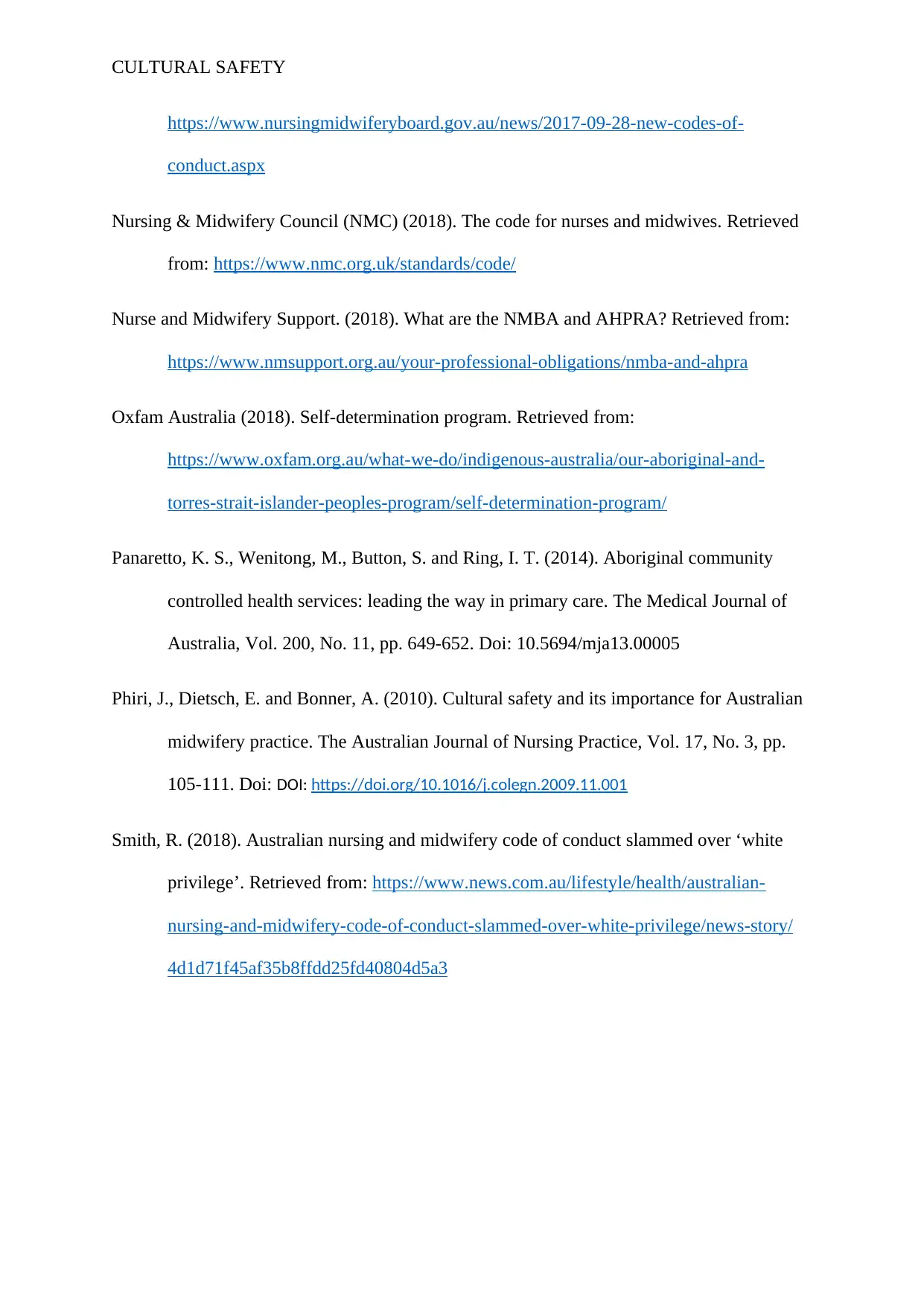
CULTURAL SAFETY
https://www.nursingmidwiferyboard.gov.au/news/2017-09-28-new-codes-of-
conduct.aspx
Nursing & Midwifery Council (NMC) (2018). The code for nurses and midwives. Retrieved
from: https://www.nmc.org.uk/standards/code/
Nurse and Midwifery Support. (2018). What are the NMBA and AHPRA? Retrieved from:
https://www.nmsupport.org.au/your-professional-obligations/nmba-and-ahpra
Oxfam Australia (2018). Self-determination program. Retrieved from:
https://www.oxfam.org.au/what-we-do/indigenous-australia/our-aboriginal-and-
torres-strait-islander-peoples-program/self-determination-program/
Panaretto, K. S., Wenitong, M., Button, S. and Ring, I. T. (2014). Aboriginal community
controlled health services: leading the way in primary care. The Medical Journal of
Australia, Vol. 200, No. 11, pp. 649-652. Doi: 10.5694/mja13.00005
Phiri, J., Dietsch, E. and Bonner, A. (2010). Cultural safety and its importance for Australian
midwifery practice. The Australian Journal of Nursing Practice, Vol. 17, No. 3, pp.
105-111. Doi: DOI: https://doi.org/10.1016/j.colegn.2009.11.001
Smith, R. (2018). Australian nursing and midwifery code of conduct slammed over ‘white
privilege’. Retrieved from: https://www.news.com.au/lifestyle/health/australian-
nursing-and-midwifery-code-of-conduct-slammed-over-white-privilege/news-story/
4d1d71f45af35b8ffdd25fd40804d5a3
https://www.nursingmidwiferyboard.gov.au/news/2017-09-28-new-codes-of-
conduct.aspx
Nursing & Midwifery Council (NMC) (2018). The code for nurses and midwives. Retrieved
from: https://www.nmc.org.uk/standards/code/
Nurse and Midwifery Support. (2018). What are the NMBA and AHPRA? Retrieved from:
https://www.nmsupport.org.au/your-professional-obligations/nmba-and-ahpra
Oxfam Australia (2018). Self-determination program. Retrieved from:
https://www.oxfam.org.au/what-we-do/indigenous-australia/our-aboriginal-and-
torres-strait-islander-peoples-program/self-determination-program/
Panaretto, K. S., Wenitong, M., Button, S. and Ring, I. T. (2014). Aboriginal community
controlled health services: leading the way in primary care. The Medical Journal of
Australia, Vol. 200, No. 11, pp. 649-652. Doi: 10.5694/mja13.00005
Phiri, J., Dietsch, E. and Bonner, A. (2010). Cultural safety and its importance for Australian
midwifery practice. The Australian Journal of Nursing Practice, Vol. 17, No. 3, pp.
105-111. Doi: DOI: https://doi.org/10.1016/j.colegn.2009.11.001
Smith, R. (2018). Australian nursing and midwifery code of conduct slammed over ‘white
privilege’. Retrieved from: https://www.news.com.au/lifestyle/health/australian-
nursing-and-midwifery-code-of-conduct-slammed-over-white-privilege/news-story/
4d1d71f45af35b8ffdd25fd40804d5a3
⊘ This is a preview!⊘
Do you want full access?
Subscribe today to unlock all pages.

Trusted by 1+ million students worldwide
1 out of 9
Related Documents
Your All-in-One AI-Powered Toolkit for Academic Success.
+13062052269
info@desklib.com
Available 24*7 on WhatsApp / Email
![[object Object]](/_next/static/media/star-bottom.7253800d.svg)
Unlock your academic potential
Copyright © 2020–2025 A2Z Services. All Rights Reserved. Developed and managed by ZUCOL.





